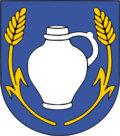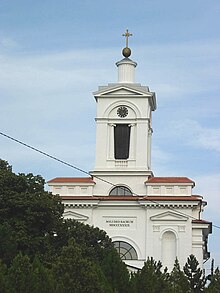Padina (Kovačica)
|
Падина Padina |
||||
|
||||
| Basic data | ||||
|---|---|---|---|---|
| State : | Serbia | |||
| Province : | Vojvodina | |||
| Okrug : |
Južni Banat |
|||
| Opština : | Kovačica | |||
| Coordinates : | 45 ° 7 ' N , 20 ° 44' E | |||
| Height : | 110 m. i. J. | |||
| Residents : | 6,459 (2005) | |||
| Telephone code : | (+381) 013 / 667,668 | |||
| Postal code : | 26 215 | |||
| License plate : | PA | |||
| Structure and administration | ||||
| Mayor : | Janko Kolarik | |||
Padina ( Cyrillic Падина ) is a municipality in the municipality of Kovačica in the southern Banat administrative district in the autonomous Serbian province of Vojvodina with about 7,000 inhabitants, 99% of whom are of Slovak ethnicity . Padina was settled in 1806 by Slovak families from central Slovakia , but the name Padina is of Serbian origin (Padina = slope).
Even before Padina was founded, there was a settlement with the same name in this area, which was inhabited by Romanians and later by Serbs , but due to the harsh living conditions, all residents of the settlement migrated.
At that time Vojvodina still belonged to Austria-Hungary and the border with the Ottoman Empire was in this area . Padina was founded as a border village to secure the military border . The situation in this area was increasingly destabilized by the first Serbian uprising in 1804. The military leaders of the Habsburg monarchy decided to better control and fortify the border. Padina should be populated by Slovaks and Samoš by Serbs.
The military measured 83 plots and had simple mud houses built on them. Better materials were used for the public buildings. After two years of construction, Padina was able to welcome the new residents under difficult conditions. The Slovaks came to Padina in two groups. The first group came in 1806, the second group in 1808. Each group consisted of 80 families, most of whom came from the counties of Neograd , Pest and Gemer . Some families also came from the Liptov and Nitra counties .
Because the number of settlers in 1806 was insufficient for the area, the first priest, Martin Hamaliar, suggested that Archduke Ludwig bring a second group of settlers into the country. The Archduke promised to have new wells dug in Padina. As a thank you, at the suggestion of Hamaliar, the place should be renamed Ludwigsdorf, which in Hungarian became Lajošfalva and, as the place grew, Nadlajošfalva (Nagylajosfalva). The residents continued to use the name Padina.
Life for the first Slovak families was not easy. They suffered from a lack of water and the frequent sand winds that developed in the dunes of the Deliblatska peščara . In the first years after the town was founded, the water supply in Padina was difficult. The well did not provide enough water, so the residents had to fetch water from the village of Kovačica . In 1814 there were still no other wells, so the settlers intended to leave the country, which the military leadership did not allow. At the request of Jan Stehlo, five wells were dug in Padina in 1817.



